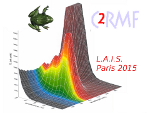Easel paintings contain various pigments dispersed in an organic matrix. From the Renaissance to the 20th century, lead white was the most common pigment, present in the preparation layers as well as in the paint layers, sometimes mixed with other colours. Lead white is composed of two main lead carbonates phases [3], i.e. cerussite PbCO3 and hydrocerussite 2PbCO3.Pb(OH)2.
Historical sources reveal that various qualities of this pigment were proposed to the artist, and sold at very different prices. A thorough examination of treatises shows that the main quality marker of the lead white pigment was its optical features: after the pigment was synthesized, several post-synthesis treatments were applied, possibly in order to gain those desired optical characteristics. The optical and luminescence properties of the two phases of interest thus constitute an interesting issue, with applications in the field of art history: the aim is to connect manufacture recipes of the past with those properties.
This work proposes new insights on the luminescence of cerussite and hydrocerussite. The two phases were synthesized in the laboratory. Fluorescence studies were performed using a EKPSLA pulsed laser (10 Hz), with excitation energies between 3 and 5 eV, combined with an ICCD camera. The signal was analyzed with an ACTON SP2300 monochromator. This contribution will propose explanations for the various emissions detected. Furthermore, new insights on the ionoluminescence of the cerussite phase will be given, based on irradiation at the AGLAE facility (C2RMF).
- Other

 PDF version
PDF version

